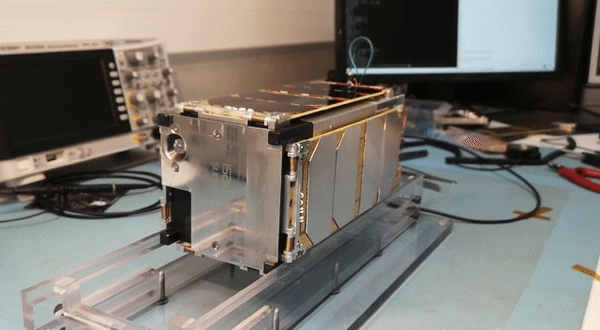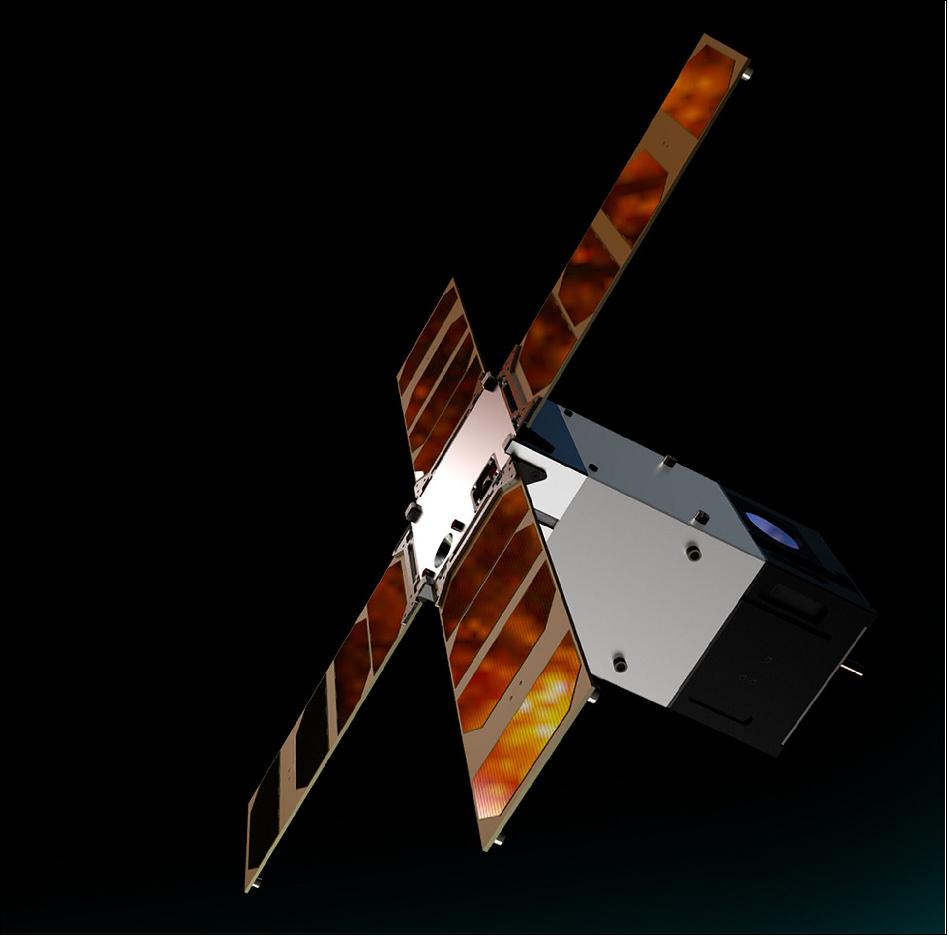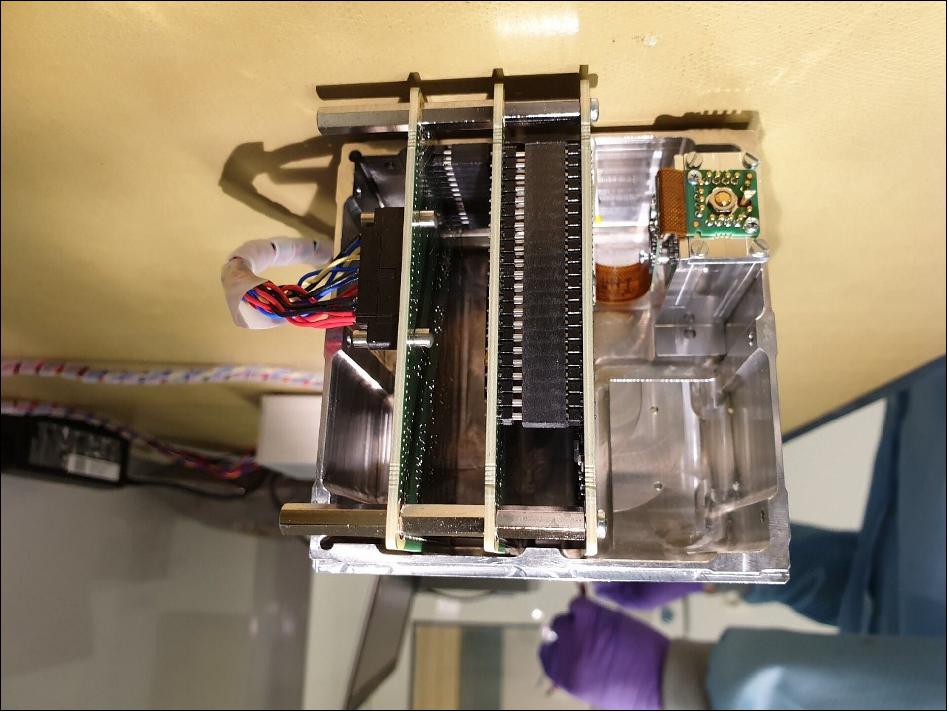Sunstorm CubeSat
Non-EO
ESA
Operational (nominal)
Quick facts
Overview
| Mission type | Non-EO |
| Agency | ESA |
| Mission status | Operational (nominal) |
| Launch date | 17 Aug 2021 |
Sunstorm CubeSat demonstration mission
Launch Mission Status X-Ray Flux Monitor References
ESA (European Space Agency) is increasingly utilizing small CubeSat nanosatellites. These are employed for the In-Orbit Demonstration (IOD) of miniaturized technologies and for small payload-driven missions, as well as ESA Education activities. The objective of the Sunstorm mission,led by Finland’s Reaktor Space Lab with its payload coming from a Finnish-UK consortium, is to demonstrate a highly miniaturized solar X-Ray Flux Monitor (XFM) technology for Space Weather monitoring and forecasting. It is planned to fly in 2021.
Sunstorm is a 2U CubeSat. The industry team is composed of ISAWARE, Aboa Space Research Oy, Oxford Instruments Technologies and Talvioja Consulting and the mission is funded by ESA and Business Finland. The instrument will later be sent to space on an ESA’s Lagrange-space weather satellite. 1)

This 2U CubeSat will fly an innovative solar X-ray spectrometer to detect the X-ray pulses produced by coronal mass ejections – massive eruptions of many millions of tons of material from the Sun’s surface. These give rise in turn to solar storms, threatening potentially harmful effects on satellites and terrestrial power and communications networks, even aircraft on polar flights.
Once demonstrated in space, a follow-on version of the instrument will be flown on ESA’s Lagrange operational space weather monitoring mission.

Launch
The Sunstorm passenger payload was launched on 17 August 2021 (at 01:47 UTC) as a technology demonstration mission on the Vega SSMS piggyback mission VV19 of Arianespace from Kourou. The primary mission on this flight was Pleiades Neo-4 of CNES/Airbus. 2) 3)
Orbit of Secondary Payloads
Sun-synchronous orbit with an altitude of 551 km.
Passenger Payloads
The 19th mission of Europe’s Vega light launcher also injected four CubeSats on a sun-synchronous orbit, three for the European Space Agency (ESA) and one for the French start-up Unseenlabs. The three ESA payloads were under contract with SAB Launch Services of Italy. In order to meet their clients’ needs and to ensure them a quicker access to Space, Arianespace and SAB Launch Services set up a collaboration to integrate all four auxiliary passengers in two PSL6U Deployers installed on the Payload Adapter.
• LEDSAT, a 1U CubeSat of Sapienza University of Rome, Italy.
• RadCube, a 3U CubeSat from C3S, Hungary, to demonstrate miniaturized instrument technologies that measure in-situ the space radiation and magnetic field environment in Low Earth Orbit for space weather monitoring purposes;
• Sunstorm, a 3U CubeSat from RSL, Finland, with an innovative solar X-ray spectrometer to detect the X-ray pulses produced by coronal mass ejections – massive eruptions of many millions of tons of material from the Sun’s surface.
• BRO-4, the fourth 6U CubeSat from Unseenlabs, France, of the constellation BRO (Breizh Reconnaissance Orbiter), a spectrum monitoring and electromagnetic intelligence service for maritime surveillance.
Mission Status
• August 27, 2021: ESA’s Sun-watching Sunstorm CubeSat has produced its first solar X-ray spectrum, coming just over a week after its launch to orbit aboard a Vega rocket. 4)
- Sunstorm continues its in-orbit operations and the final stages of its commissioning, explains Janne Kuhno of Reaktor Space Lab: “The early operations went very quickly and we managed to stabilize bi-directional S-band communications on the first pass, perform platform avionics health checks, deploy all four solar panels and acquire Sun pointing attitude for payload operations.”

- “Acquiring our first solar X-ray spectrum so quickly after launch is a major achievement in itself,” notes Camille Pirat, ESA Technical Officer for the Sunstorm mission.
- “It is also good news for our forthcoming space weather mission, also carrying a version of the XFM-CubeSat instrument – which was previously known as Lagrange but is currently the subject of a naming competition.”
- A second ESA CubeSat was also launched with Sunstorm, explains Roger Walker, overseeing ESA's Technology CubeSats: “The radiation-detecting RadCube, developed by a team from Hungary, Poland the UK, is also undergoing commissioning, with its first results expected next month.”
XFM (X-Ray Flux Monitor)
ESA's GSTP (General Support Technology Program) activity will launch an X-ray flux monitor into space in 2021 – bringing Europe closer to gaining autonomy over its own space weather forecasts and providing valuable redundancy for space weather forecasters globally. 5)
Solar flares are linked to a variety of space weather processes that can negatively interfere with things on Earth, such as communications. Associated coronal mass ejections can induce radiation storms affecting satellites, create ionospheric disturbances impacting satellite navigation systems and interfere with our planet’s magnetosphere – creating currents that can affect ground systems including power distribution networks. By measuring X-ray emissions from the Sun, we can predict when these space weather events might occur and prepare for them.
Currently, most of our data about this applied to space weather operations comes from the US, who already have instruments in space to measure the X-ray flux from the Sun, but this is about to change.
A GSTP activity will launch an X-ray flux monitor into space in 2021 – bringing Europe closer to gaining autonomy over its own space weather forecasts and providing valuable redundancy for space weather forecasters globally.
The innovative instrument will also measure X-rays in a new way, collecting more information based on both X-ray fluxes and high-resolution spectra.
Measuring solar X-rays in space is not a new idea and the XFM-CubeSat instrument uses technologies that have previously been flown, reducing the risk and making it possible to go from concept, to design and flight testing in a single contract. One new element to be demonstrated is the silicon drift diode, barely bigger than an ant, which detects X-rays as pulses and is read out by a small analog board before being discretized and packaged by energy on the FPGA processor board. The performance of the pulse processing electronics, to be able to measure the largest flares without saturation, constitutes one of the biggest challenges for the instrument development.
The monitor has undergone environmental testing and the team who built it are confident that it will survive in the harsh conditions of space, when it launches on Sunstorm. Flying on a CubeSat means that the testing was not required to be as rigorous, time consuming or costly as is usual for space instrumentation but provides an ideal opportunity to demonstrate the concept in space. This is essential, as there are no sources on ground that provide the same spectrum of X-rays coming from the Sun that do not make it through the Earth’s atmosphere. Although the instrument must fit into a box less than 10 x 10 x 8 cm.

References
1) ”Sunstorm ready for sunlight,” ESA-Agency, February 5, 2021, URL: https://www.esa.int/ESA_Multimedia/Images/2020/02/Sunstorm_ready_for_sunlight
2) ”19th Vega mission demonstrates Arianespace’s ability to deliver for the most innovative projects for the benefits of its clients,” Arianespace Press Release, 17 August 2021, URL: https://www.arianespace.com/press-release/vv19-vega-launch-success/
3) ”Vega launches Pléiades Neo and CubeSats,” ESA Enabling & Support, 17 August 2021, URL: https://www.esa.int/Enabling_Support/Space_Transportation
/Vega/Vega_launches_Pleiades_Neo_and_CubeSats
4) ”First light from Sunstorm CubeSat,” ESA Enabling & Support, 27 August 2021, URL: https://www.esa.int/ESA_Multimedia/Images/2021/08/First_light_from_Sunstorm_CubeSat
5) ”New X-ray flux monitor to bring better space weather forecasts,” ESA Enabling & Support, 29 January 2021, URL: https://www.esa.int/Enabling_Support/Space_Engineering_Technology/
Shaping_the_Future/New_X-ray_flux_monitor_to_bring_better_space_weather_forecasts
The information compiled and edited in this article was provided by Herbert J. Kramer from his documentation of: ”Observation of the Earth and Its Environment: Survey of Missions and Sensors” (Springer Verlag) as well as many other sources after the publication of the 4th edition in 2002. - Comments and corrections to this article are always welcome for further updates (eoportal@symbios.space).
Launch Mission Status X-Ray Flux Monitor References Back to top